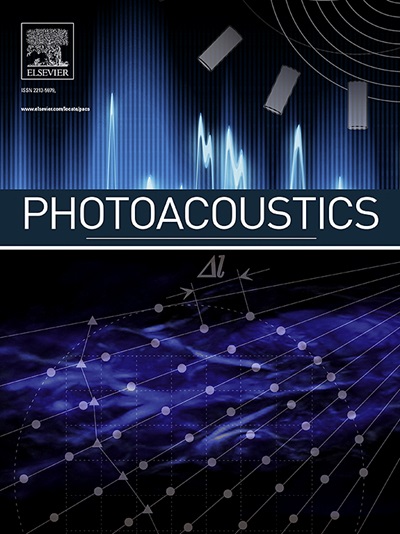对比增强多光谱光声断层扫描对囊性纤维化患者胃肠道运输的评估
IF 6.8
1区 医学
Q1 ENGINEERING, BIOMEDICAL
引用次数: 0
摘要
囊性纤维化(CF)影响胃肠道,但评估胃肠道运输通常需要侵入性手术或暴露于电离辐射。对比增强的多光谱光声断层扫描(CE-MSOT)提供了一种新的、无创的、无辐射的方法,通过口服染料来评估胃肠道功能。在这项临床试点研究中,5名囊性纤维化患者和4名健康志愿者在标准化早餐前和早餐后分别接受CE-MSOT治疗,每小时6次,早餐时使用吲哚青素绿(ICG)作为染料。记录胃窦、回肠末端和乙状结肠,对MSOT信号进行频谱分离,检测ICG信号,确定传递时间。粪便标本的荧光成像证实ICG排泄。CF患者回肠末端检测到MSOT ICG信号较早,在摄入ICG后120 min (p = 0.0079)达到最大值,而健康对照组为240 min (p = 0.0286)(p = 0.0159)。在CF患者中,从240 min开始在乙状结肠进一步检测到ICG信号(300 min后p = 0.0079)。对照组乙状结肠ICG信号未见明显变化。此外,19份粪便样本中有12份通过荧光成像证实了ICG信号。在这项研究中,我们证明了CE-MSOT对CF患者肠道功能成像的潜力,并揭示了CF患者的肠道运输速度比健康对照组更快。本文章由计算机程序翻译,如有差异,请以英文原文为准。
Contrast-enhanced multispectral optoacoustic tomography for the assessment of the gastrointestinal transit in patients with cystic fibrosis
Cystic fibrosis (CF) affects the gastrointestinal tract, but assessing gastrointestinal transit usually requires invasive procedures or exposure to ionizing radiation. Contrast-enhanced multispectral optoacoustic tomography (CE-MSOT) offers a novel, non-invasive, and radiation-free approach to assess gastrointestinal function by orally administered dyes. In this clinical pilot-study five patients with cystic fibrosis and four healthy volunteers received CE-MSOT before and 6-times hourly after a standardized breakfast with Indocyanin green (ICG) as dye. The gastric antrum, terminal ileum and sigmoid colon were recorded and MSOT signals spectrally unmixed to detect ICG signals to determine the transit time. ICG excretion was confirmed by fluorescence imaging of stool samples. MSOT ICG signals were detected earlier in the terminal ileum of CF patients, reaching a maximum after 120 min (p = 0.0079), compared to 240 min (p = 0.0286) in healthy controls after ICG intake (p = 0.0159). In CF patients, ICG signal was further detected in the sigmoid colon from 240 min onwards (p = 0.0079 after 300 min). But, no significant changes in the ICG signal were observed in the sigmoid colon of controls. Furthermore, signals of ICG were verified in 12 of 19 stool samples by fluorescence imaging. In this study, we demonstrated the potential of CE-MSOT for functional imaging of the intestine in CF patients and revealed faster intestinal transit in CF patients compared to healthy controls.
求助全文
通过发布文献求助,成功后即可免费获取论文全文。
去求助
来源期刊

Photoacoustics
Physics and Astronomy-Atomic and Molecular Physics, and Optics
CiteScore
11.40
自引率
16.50%
发文量
96
审稿时长
53 days
期刊介绍:
The open access Photoacoustics journal (PACS) aims to publish original research and review contributions in the field of photoacoustics-optoacoustics-thermoacoustics. This field utilizes acoustical and ultrasonic phenomena excited by electromagnetic radiation for the detection, visualization, and characterization of various materials and biological tissues, including living organisms.
Recent advancements in laser technologies, ultrasound detection approaches, inverse theory, and fast reconstruction algorithms have greatly supported the rapid progress in this field. The unique contrast provided by molecular absorption in photoacoustic-optoacoustic-thermoacoustic methods has allowed for addressing unmet biological and medical needs such as pre-clinical research, clinical imaging of vasculature, tissue and disease physiology, drug efficacy, surgery guidance, and therapy monitoring.
Applications of this field encompass a wide range of medical imaging and sensing applications, including cancer, vascular diseases, brain neurophysiology, ophthalmology, and diabetes. Moreover, photoacoustics-optoacoustics-thermoacoustics is a multidisciplinary field, with contributions from chemistry and nanotechnology, where novel materials such as biodegradable nanoparticles, organic dyes, targeted agents, theranostic probes, and genetically expressed markers are being actively developed.
These advanced materials have significantly improved the signal-to-noise ratio and tissue contrast in photoacoustic methods.
 求助内容:
求助内容: 应助结果提醒方式:
应助结果提醒方式:


